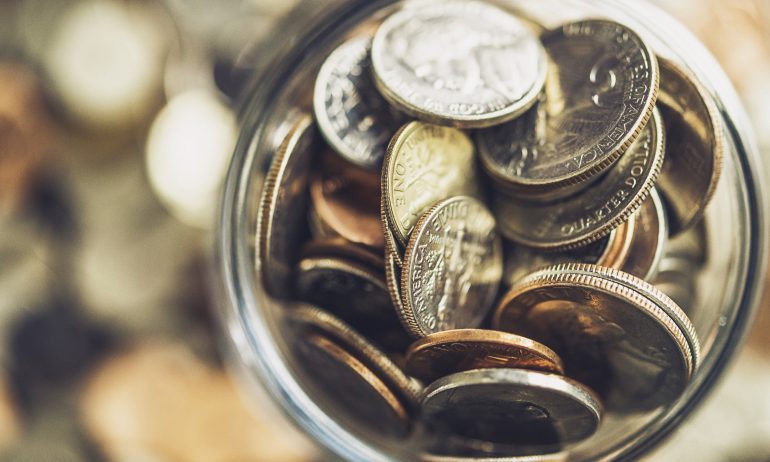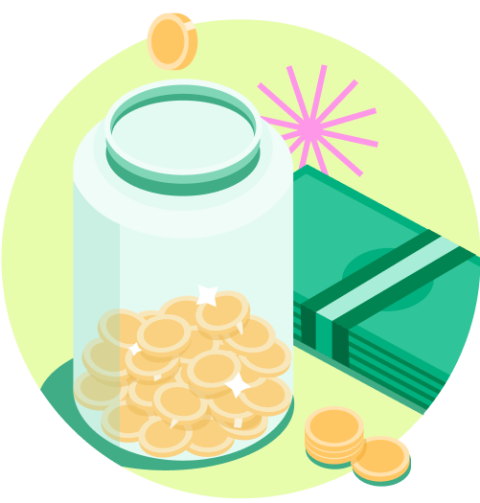You’re our first priority.
Every time.
We believe everyone should be able to make financial decisions with confidence. And while our site doesn’t feature every company or financial product available on the market, we’re proud that the guidance we offer, the information we provide and the tools we create are objective, independent, straightforward — and free.
So how do we make money? Our partners compensate us. This may influence which products we review and write about (and where those products appear on the site), but it in no way affects our recommendations or advice, which are grounded in thousands of hours of research. Our partners cannot pay us to guarantee favorable reviews of their products or services. Here is a list of our partners.
What Is a Savings Account?

Senior Writer | Savings accounts, money market accounts, banking

Many, or all, of the products featured on this page are from our advertising partners who compensate us when you take certain actions on our website or click to take an action on their website. However, this does not influence our evaluations. Our opinions are our own. Here is a list of our partners and here's how we make money.
Visit your My NerdWallet Settings page to see all the writers you're following.
Table of Contents
What is a savings account?
A savings account is a deposit account that typically earns interest, is federally insured and held at a financial institution, such as a bank or credit union. With an interest-bearing account, the bank pays you to keep your funds deposited, with annual percentage yields on some accounts reaching over 5%.
As deposit accounts, savings accounts are by definition federally insured up to at least $250,000. This means you won’t lose your money (up to at least $250,000) if the bank fails. (Read more about federal insurance for banks and federal insurance for credit unions).

Member FDIC
SoFi Checking and Savings

4.60%SoFi members with Direct Deposit or $5,000 or more in Qualifying Deposits during the 30-Day Evaluation Period can earn 4.60% annual percentage yield (APY) on savings balances (including Vaults) and 0.50% APY on checking balances. There is no minimum Direct Deposit amount required to qualify for the stated interest rate. Members without either Direct Deposit or Qualifying Deposits, during the 30-Day Evaluation Period will earn 1.20% APY on savings balances (including Vaults) and 0.50% APY on checking balances. Interest rates are variable and subject to change at any time. These rates are current as of 10/24/2023. There is no minimum balance requirement. Additional information can be found at http://www.sofi.com/legal/banking-rate-sheet.
$0

Member FDIC
EverBank Performance℠ Savings

5.05%
$0

Member FDIC
Barclays Tiered Savings Account

4.80%1.00% APY for <$10k balance; 4.00% APY for $10k to <$50k balance; 4.50% APY for $50k to <$250k; 4.80% APY for $250k+ balance
$250,000

on Wealthfront's website
Wealthfront Cash Account

5.00%
$1

on Betterment's website
Betterment Cash Reserve – Paid non-client promotion

5.50%*Current promotional rate; annual percentage yield (variable) is 5.50% as of 4/2/24, plus a .50% boost available as a special offer with qualifying deposit. Terms apply; if the base APY increases or decreases, you’ll get the .75% boost on the updated rate. Cash Reserve is only available to clients of Betterment LLC, which is not a bank; cash transfers to program banks conducted through clients’ brokerage accounts at Betterment Securities.
$0

Member FDIC
Marcus by Goldman Sachs High-Yield CD

5.10%5.10% APY (annual percentage yield) as of 06/25/2024
6 months
Bask Bank CD

5.30%The annual percentage yield is effective as of Wednesday, July 24, 2024. APY is a fixed rate and a $1,000 minimum balance is required. Bask Bank will pay this rate and APY through your CD maturity date. Fees could reduce the earnings on your account, and an early withdrawal penalty may be imposed for early withdrawal. If your CD is not funded with at least $1,000 within 10 business days after the date the account is opened, it will automatically be closed. Read the full terms here: https://www.baskbank.com/terms-and-disclosures.pdf
9 months

Member FDIC
Marcus by Goldman Sachs High-Yield CD

5.15%5.15% APY (annual percentage yield) as of 06/25/2024
1 year

Member FDIC
Discover® Cashback Debit

N/A
$0

Member FDIC
Chase Total Checking®

N/A
$12

Deposits are FDIC Insured
Chime Checking Account

N/A
$0

Member FDIC
Discover® Money Market Account

4.00%
$0
Why you need a savings account
Using a savings account creates some distance between everyday spending money that’s kept in your checking account and cash that's needed later, whether for an unexpected emergency, a planned vacation or any other reason. Savings accounts also typically earn more interest than checking accounts.
What you need to know about savings accounts
When you put money in a savings account, the funds are used by the bank to make loans to other customers and businesses. The bank makes money from those loans, so it is able to pay you a little interest in return. But "a little interest" is all too true for many big banks, which often offer low rates of 0.01% APY. In fact, the average national rate for savings accounts is only 0.45%.
Additionally, inflation can chip away at the value of money you have saved over time. You can see how it works with our inflation calculator.
But you can find much higher rates at online banks. Online institutions don't have to support expensive brick-and-mortar branches, enabling many of them to offer APYs that are significantly higher than the national average. And some online accounts offer ATM cards, so you can easily access your funds by visiting a local ATM to make a withdrawal. The accounts also tend to have low deposit minimums and typically don't charge monthly maintenance fees.
Savings accounts with strong APYs can help your money grow
If you put $10,000 in a savings account that earns a 0.01% APY, you’d earn only one dollar after one year. But if you put that same amount of money in a high-yield online savings account that earns a 5% APY, you’d earn more than $500 after a year. That’s a big difference for not much effort.
But you don’t need $10,000 to take advantage of high yields. You can calculate your earnings on any amount using NerdWallet’s savings calculator.

How a savings account works: withdrawal limits
Cash in savings accounts isn't as accessible as in checking accounts. Banks typically limit the number of certain transfers from a savings account — online withdrawals, for example — to six a month. Making additional transfers of these types can result in a fee for each transaction over the limit.
The six-per-month withdrawal cap used to be a federal requirement, but in April 2020, the Federal Reserve removed the limit in response to widespread financial distress caused by the pandemic. As a result, some banks and credit unions relaxed this restriction.
Other types of withdrawals that are less convenient, such as taking money out through a teller or ATM, typically don’t count toward the six-per-month figure. You will want to check with a financial institution to know its specific policies. (Read more in this primer on savings account withdrawal limits.)
However, it’s worth noting that if you tend to withdraw cash for splurge expenses that work against your savings goals, withdrawal limits can be a blessing in disguise. Savings accounts help you store money you don’t need immediately. By avoiding excessive savings withdrawals, you help ensure your money is there when you do need it.
If you need easier access to cash for everyday spending, consider opening a checking account. You can read NerdWallet's list of best checking accounts to find ones that don't have monthly maintenance fees and might even earn interest.
How much to keep in your savings account
You generally want to keep building up your savings account until you reach an amount that could cover three to six months’ worth of living expenses. That can help protect you in case of job loss or another financial emergency.
You can start by making automatic deposits from checking to savings on a regular basis, such as each payday. If you’re able to save $25 a week, for example, it adds up to more than $500 after five months. That could help you pay for an unexpected expense, such as a surprise car repair bill, without going into debt.
If you have the ability, consider using a savings account to save for additional short-term savings goals, such as a car or special vacation. But if you have a cushion and want to save for longer-term goals, such as retirement, consider putting extra funds into investments.
Alternatives to savings accounts
There are other short-term savings options that don't involve investment risk. Here are a few alternatives.
Money market accounts are savings accounts that can have some checking features. For example, they might come with a debit card or the ability to write checks. But as with regular savings accounts, transactions may be limited to a handful per month. You may be charged a fee for each transaction that goes over that limit.
» Learn more about money market accounts
Certificates of deposit, or CDs, hold money for a fixed term, anywhere from a few months to a few years. Generally, the longer the term, the higher the interest rate. Open a CD only with money you won't need immediately, because withdrawing money before the end of the term usually carries a financial penalty of several months’ interest.
» Read up on what CDs are and how they work
Cash management accounts, or CMAs, are cash accounts that have features similar to checking, savings and investments. They are typically offered by nonbank financial service providers like investment firms or robo-advisors. They pay interest and can be especially convenient if you have an investment account with the same provider. (Read more about CMAs)
Where to find the best savings accounts
Start your search by looking at online banks and credit unions. These types of financial institutions, which are heavily featured in NerdWallet's list of best savings accounts, tend to keep fees to a minimum, offer good rates and usually have strong highly-rated mobile apps to help you manage your savings. However, if you plan to do most of your banking at a neighborhood branch, consider accounts at a local credit union.
If you prefer a large bank, review NerdWallet’s list of some of the best national banks.
A good savings account provides a safe place to park your money while it also earns interest. By opening one with strong rates and low fees, and by making regular deposits, you can help make sure you have funds set aside for your savings goals.
To open a savings account, submit an application, either online or at the bank or credit union branch. You’ll need to provide your Social Security number and contact information, along with at least one form of identification, such as a driver’s license or a passport. (For a joint account, everyone wanting access to the account must provide this information and ID.) The bank will often require you to deposit money into the new account right away. You can do that by depositing cash or checks, external transfer from a different account or through a wire transfer.
At insured financial institutions, funds in savings accounts are federally insured up to $250,000 per depositor, per bank and per ownership category (examples of ownership categories include “single accounts” or “joint accounts”). That means that if the bank or credit union fails, you can claim your money, up to the insured amount. Read more in our explainers on FDIC and NCUA insurance.
A savings account is valuable because it’s a safe place to keep money, thanks to federal insurance. It's a good place to keep your emergency fund, for example. It can earn interest and is separate from your checking account — which is used for everyday spending — but also easy to access when needed.
To open a savings account, submit an application, either online or at the bank or credit union branch. You’ll need to provide your Social Security number and contact information, along with at least one form of identification, such as a driver’s license or a passport. (For a joint account, everyone wanting access to the account must provide this information and ID.) The bank will often require you to deposit money into the new account right away. You can do that by depositing cash or checks, external transfer from a different account or through a wire transfer.
At insured financial institutions, funds in savings accounts are federally insured up to $250,000 per depositor, per bank and per ownership category (examples of ownership categories include “single accounts” or “joint accounts”). That means that if the bank or credit union fails, you can claim your money, up to the insured amount. Read more in our explainers on
FDIC
and
NCUA
insurance.
A savings account is valuable because it’s a safe place to keep money, thanks to federal insurance. It's a good place to keep your emergency fund, for example. It can earn interest and is separate from your checking account — which is used for everyday spending — but also easy to access when needed.









